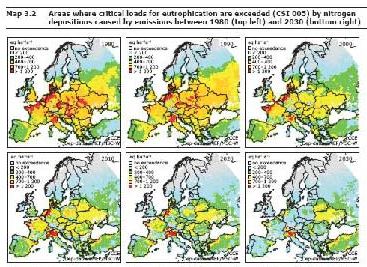Also discussed here: Effects of air pollution on European ecosystems (Diego Fdez-Sevilla, Press release, European Environment Agency technical report, Jun. 30, 2014)
Today we review a report describing progress made by European countries in reducing air pollution from burning vehicle emissions and the use of agricultural fertilizers over the last decade or two, with respect to the impact it has on the natural environment which is impacted when critical thresholds or loadings are exceeded. While action on acid rain has almost eliminated the SO2 acidification impacts, eutrophication continues to be a problem in southeast-central Europe where fish and flowering plants are impacted. More than 50% of the ecological systems will still be at risk of excessive nutrient N deposition in 2020.

Key Quotes:
“ This report focuses on the deposition of airborne sulphur (S) and nitrogen (N) compounds and their negative effects on ecosystems. N- and S-containing air pollutants are released to the atmosphere by combustion processes such as the burning of coal or petrol, and by non-combustion processes such as agricultural fertiliser application”
“an ecosystem is at risk of acidification or eutrophication when its critical load is exceeded by acidifying and eutrophying air pollutants, respectively. When critical loads are exceeded the actual damage to sensitive elements of an ecosystem may involve a time delay, dependent on soil, water and vegetation properties as well as combined effects due to for example climate change”
“Although air pollution does not cause as much harm as it once did, we are still struggling to protect sensitive ecosystems from harmful effects such as eutrophication. This changes habitats, endangering a wide range of species from fish to flowering plants. It is particularly striking that the problem appears to be just as bad in Europe’s protected natural areas.”
“As SO2 emissions have fallen, the relative contribution made by ammonia (NH3) emitted from agricultural activities and nitrogen oxides (NOX) emitted from combustion processes to surface water and soil acidification has increased or even become predominant in some regions in Europe. NH3 and NOX are also eutrophying air pollutants.”
“When implementing current legislation, more than 50 % of the ecosystem areas classified according to the EUNIS habitats classification are expected to be still at risk of excessive nutrient N deposition in 2020.”






No comments:
Post a Comment